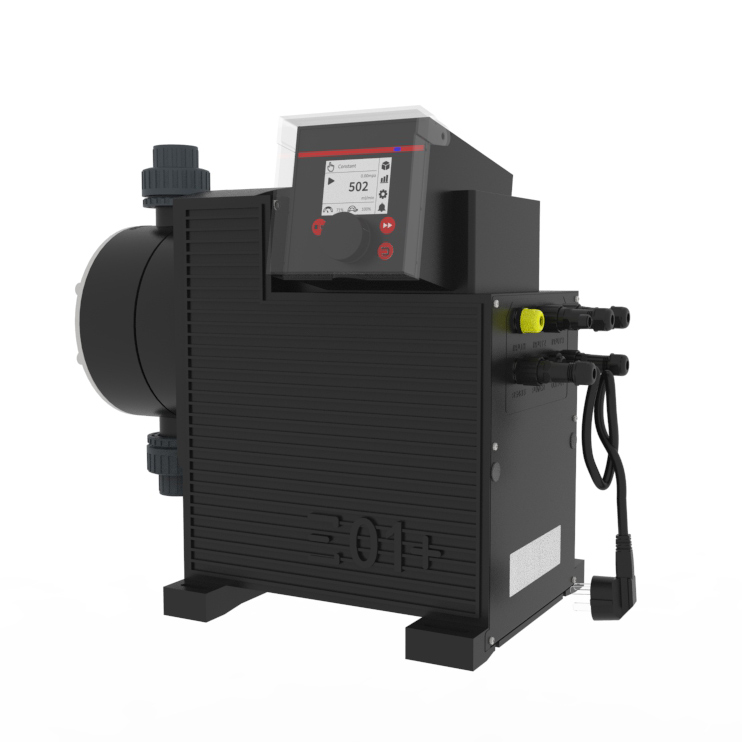How Do Digital Dosing Pumps Improve Accuracy and Control?
Digital dosing pumps have transformed fluid metering industries by blending precision, efficiency, and intelligent control. Unlike traditional mechanical dosing devices, digital designs provide accuracy, real-time monitoring, and adaptive performance for complex process environments. This comprehensive article explains the benefits of these systems and provides an in-depth look at their applications and capabilities.
Why Go Digital? Key Advantages of Digital Dosing
According to industry specialists, digital dosing pumps deliver several transformative advantages over mechanical models:
1.Exceptionally High Accuracy
Digital pumps maintain precise control across wide flow ranges thanks to high turn-down ratios. They dynamically adjust stroke speed and frequency, maintaining tight dosing accuracy without manual stroke-length adjustment .
2. Pulse-Free, Continuous Flow
The stroke modulation in digital systems provides smooth fluid delivery even when adjusting flow rates, improving pump efficiency and minimizing downstream turbulence.
3. Minimal Air-Lock Risk
Mechanical pumps often suffer from dosing failure due to trapped air (especially with off-gassing chemicals like sodium hypochlorite). Digital pumps continuously monitor diaphragm behavior and adjust to resume uninterrupted dosing .
4. Fewer Auxiliary Devices Needed
Integrated features like flow monitoring and pressure control reduce the need for external components (e.g., pulsation dampeners or additional flowmeters), simplifying system design and lowering costs .
5. Enhanced Reliability and Maintenance
Continuous diagnostics, intelligent control, and modular designs reduce downtime, optimize chemistry use, and extend pump life .
Key Features of Wearable's Digital Dosing Pump
Our company’s digital dosing pump is built on these industry benefits and adds several advanced capabilities:
Diaphragm metering driven by Huawei-chip-based algorithms and servo motors, offering ±0.24% dosing accuracy.
YLC pressure sensors monitor diaphragm motion, pipeline pressure, bubbles, and blockages, triggering automatic alarms and exhaust cycles.
Quick installation and intuitive interface for rapid deployment and easy operation.
Automatic flow control ensures dosing remains consistent under fluctuating system conditions.
Multiple operating modes: manual, concentration, impulse, batch, current-based, pause-work, weekly scheduling, and ROC external control.
Seamless integration with PLC or SCADA systems via analog/digital I/O and communication protocols.
Condition monitoring delivers real-time diagnostics and predictive maintenance.

Technological Comparison Table
The following table contrasts digital dosing with conventional mechanical dosing pumps:
| Feature | Mechanical Dosing Pump | Digital Dosing Pump |
| Accuracy | Moderate (±2–5%) | High (±0.24%) |
| Flow Modulation | Stroke-length adjustment, pulsation | High-speed pulse control, smooth flow |
| Air-Lock Handling | Prone until manually purged | Auto-detect & exhaust off-gassing |
| Need for Accessories | Often requires dampeners/flowmeters | Integrated sensors reduce external components |
| Diagnostics & Alarms | Manual checks | Real-time anomaly detection & alarm |
| Integration Flexibility | Basic timing or on/off control | Multiple I/O and PLC/SCADA compatibility |
In-Depth Analysis of Key Innovations
1.Real-Time Condition Monitoring
Our pump is equipped with YLC sensors for constant surveillance of pressure, diaphragm motion, bubble presence, and blockage detection. Alerts and error codes are displayed immediately, enabling fast action to prevent downtime and reduce chemical waste.
2.Programmable Flexibility & Operating Modes
- Manual: Direct flow entry (mL/min).
- Concentration: Proportional dosing based on original vs. desired concentration.
- Impulse: Flow determined by input signals (e.g. 1 mL per impulse).
- Impulse Control: Matches flow meter signals, perfect for water systems.
- Batch: Delivers a set volume per run.
- Current: Accepts 0–20 mA or 4–20 mA input.
- Pause-Work: Allows cyclical dosing (e.g. 240 min on, 30 min off).
- Weekly: Schedules up to 20 dosing intervals weekly.
- ROC: Remote control via external button or interface.
This flexibility supports precise control in diverse use cases.
3.Integration with Automation
With analog/digital inputs and communication protocols (e.g. RS485, Modbus), the pump connects directly to SCADA, PLC, or IoT systems. Remote start/stop, parameter changes, and diagnostics are all supported.
Application Scenarios
Digital dosing is widely applicable. Below are key segments:
1.Chemical Processing
Critical in chemical reactors and panels. Example: precise acid injection for pH control.
Benefits:
±0.24% accuracy ensures consistent reactions.
ABR sensors detect system anomalies to avoid over/under-dosing.
Modes like batch or concentration simplify control.
2.Water & Wastewater Treatment
Used for chlorine, coagulants, or pH agents.
Benefits:
Impulse mode supports remote flowmeter integration.
Self-exhaust alerts prevent shutdown from air lock.
Real-time diagnostics ensures safe, compliant operation.
3.Food and Beverage
Important for additives, sanitizers, and cleaning agents.
Benefits:
Hygienic diaphragm metering preserves food safety.
Accuracy ensures quality and regulatory compliance.
Simple digital interface helps non-technical staff.
4.New Energy & Battery Industry
Used for precise chemical application on EM foils or electrolytes.
Benefits:
Concentration mode enables ppm‑level control.
Multiple schedules support continuous & pulse dosing.
5.Pharmaceuticals & Labs
Ideal for reagent dispensing and titration.
Benefits:
±0.24% accuracy critical for lab repeatability.
Auto-exhaust and bubble detection maintain dosing integrity.
ROC mode allows hands-off control during experiments.
6. Second Table: Feature vs. Benefit
This table matches features to tangible advantages:
| Feature | Benefit |
| ±0.24% accuracy | Reduces waste and improves product quality |
| YLC sensors + alarms | Prevents downtime and enhances process control |
| 18,000 pulse/min resolution | Enables seamless transition between low and high flows |
| Full operating modes suite | Supports manual, auto, scheduled, and reactive dosing |
| Analog/I/O connectivity | Simplifies integration with modern control systems |
| Auto-air exhaust | Maintains operational continuity with off-gassing fluids |
| Modular, plug-and-play design | Reduces installation time and service cost |
| Intelligent monitoring | Supports predictive maintenance strategies |
Best Practices During Implementation
To maximize effectiveness:
Calibrate periodically using clean water at 20°C.
Use correct flow valves and back‑pressure components as required.
Select materials (e.g. diaphragm and seals) compatible with fluid chemistry and temperature.
Train operators in interpreting alerts and sensor data.
Use historical data for process optimization and chemical usage tracking.
Future Trends in Digital Dosing
AI-driven adaptive dosing that learns system behavior.
Wireless cloud connectivity for remote monitoring and analytics.
Self-calibrating sensors to reduce field maintenance.
Compact, combined chemical-feed solutions with pre-engineered integration.
Digital dosing pumps redefine fluid metering through precision, adaptability, and intelligence. With ±0.24% accuracy, fully automated control, real-time sensors, and multiple operation modes, these systems support reliable, flexible, and optimized outcomes in chemical dosing, water treatment, food, pharmaceuticals, and new energy manufacturing.
By clearly mapping features to operational benefits, our product positions itself as a turnkey solution that empowers customers to increase efficiency, reduce costs, and enhance system reliability—all while simplifying control and maintenance.


